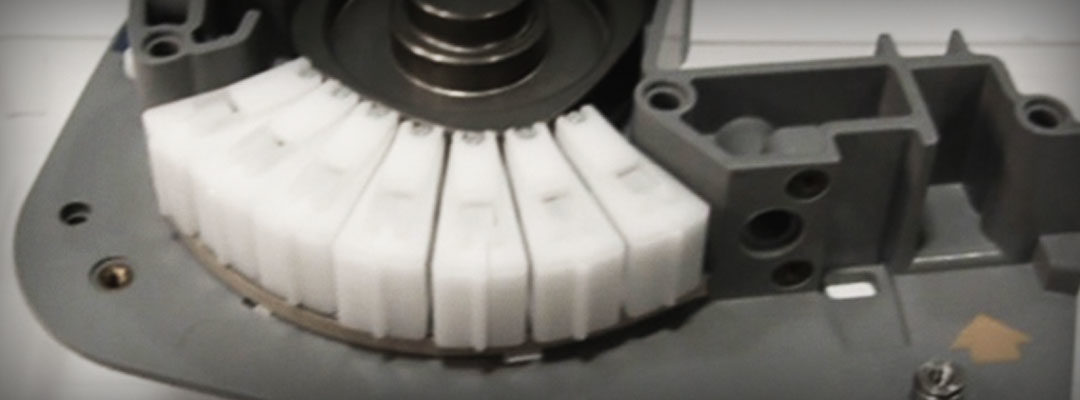Peristaltic pumps are electromechanical devices that use a series of small motor rotations to deliver fluid. Fluid is contained within flexible delivery tubing which is fitted inside the pump casing. As the motor in the pump turns, “fingers” or “rollers” squeeze and release the tubing, pushing a small amount of fluid towards the patient in a series of evenly spaced boluses, while prohibiting backflow.
Peristaltic pump motors are not constantly active during an infusion, but instead rotate in small, periodic rotations. The flow rate is controlled by changing the frequency of motor rotations.
An optimal infusion pump for critical drugs for at risk patients would combine the highest Resolution of Flow with consistent Continuity of Flow. Resolution and Continuity of Flow are controlled by the fingers or rollers built into peristaltic infusion pumps. Adding more fingers or rollers increases Continuity of Flow, while placing these fingers closer together results in smaller volume of fluid in each bolus, which leads to higher Resolution of Flow.
CURLIN ambulatory infusion pumps were designed to maximize Resolution and Continuity of Flow in an ambulatory sized device. The unique CURviLINear design of the pumping mechanism (used in all CURLIN brand ambulatory infusion pumps) essentially curves the pumping mechanism around the motor, allowing more fingers to be incorporated into a smaller space, resulting in a pump that delivers maximized Resolution and Continuity of Flow in a compact and durable footprint.
Benchtop testing indicates that the CURLIN Ambulatory Infusion Pump is able to deliver an extremely high Resolution of Flow, even at low infusion rates. At an infusion rate of 0.1 mL/hr, the CURLIN pump delivers 50 microboluses per hour (500 b/mL) compared to the 2 boluses per hour with competitive infusion pumps (20 b/mL). This translates to 1 micro-bolus every 1.2 minutes with the CURLIN pump, compared to 1 bolus per 30 minutes with competitive pumps. Fewer and smaller gaps between boluses while delivering the same amount of total fluid means the CURLIN pump delivers precise micro-boluses more accurately and more evenly throughout the infusion.

CURLIN pump delivering fluid at 0.1 mL per hour with zero head-height – calculated average: 0.1011 mL per hour
The highly efficient delivery is ideal for short half-life drugs at low flow rates, any drug delivered at a low infusion rate, and for sensitive patient populations.
CURLIN infusion pumps are rooted in decades of proven curvilinear peristaltic pump technology, driven by clinical and market needs. These pumps have been carefully engineered to maintain maximum therapeutic efficacy while meeting today’s toughest safety standards, making them an ideal infusion pump for today’s home infusion market.

Why Your Choice of Infusion Pump Matters to Patient Outcomes
Understanding How Different Infusion Pump Technologies Impact Flow Accuracy, Resolution, and Continuity
A recently published whitepaper describes how different infusion pump technologies operate, and why Resolution and Continuity of Flow are important factors when choosing an infusion pump. If you are interested in learning more, please click the button below.
